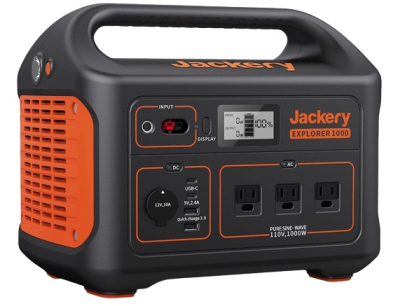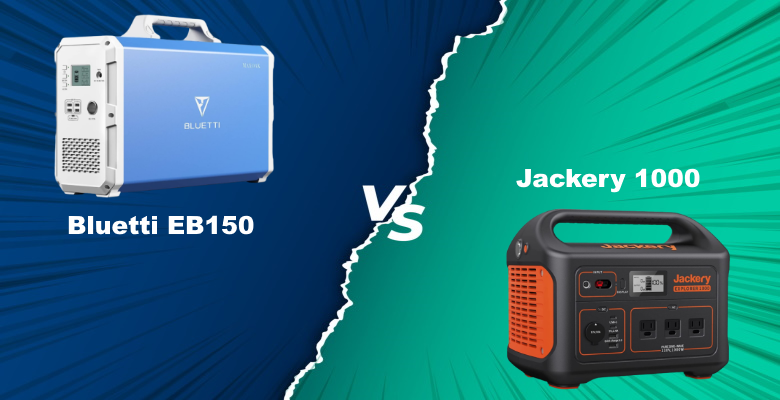Do you know what you would do in case of a power outage? What if instead of the outage being a few hours, it was going to go on for days or weeks. What would you do then? Having a rechargeable power generator is the best solution to making sure your family has a power source when the electricity grid fails. The Bluetti EB150 vs Jackery 1000 decision is a tough one because these two units are both superior options. We think the MaxOak Bluettie EB150 is the best buy when you are shopping for an emergency power solution (>>> Check on Amazon).
Bluetti EB150 vs Jackery 1000 Side by Side:
| Bluetti EB150 | Jackery 1000 | |
|---|---|---|
 |  |
|
| Wattage | 1000 watts | 1000 Watts |
| Voltage | 120V | 110V |
| Capacity | 1500Wh | 1002Wh |
| Item Weight | 37.9 Pounds | 22 Pounds |
| Item Dimensions LxWxH | 14.6 x 6.5 x 14.4 inches | 13.1 x 9.2 x 11.1 inches |
| Price | Check on Amazon | Find on Jackery.com Check on Amazon |
Comparing the Total Power Output
Both units are rated at 1,000 watts continuous output with peak output at 2,000 watts. Both units take advantage of lithium-polymer batteries that provide up to 1,000+ watt-hours of energy. That means you’ll be able to power many of the most common household appliances, charge laptops and cell phones, and use power for emergency medical devices like CPAP machines.
Output Options
These two power generators offer different ways to plug in the most important things you want to power. We will take a closer look at how the output ports vary between these devices and what that means for you.
MaxOak Bluetti EB150 Output Ports

Pros
- Ideal amount of power for most situations
- High-wattage PD port is ideal for laptops, drones, and other high-amperage applications
- Uncluttered layout of output ports works better than expected
Cons
- LCD display isn’t as nice as Jackery
The EB150 starts with dual AC outputs so you can plug in a 110 volt mini-fridge, electric drill, or a blender. The output is a converted pure sine wave pattern that ensures sensitive electronics aren’t damaged. Unlike most devices, the AC outlets are on the opposite side of the unit from the other output ports. While we initially thought this would be inconvenient, it turns out that it works really well for keeping cords and cables from getting tangled and messy.
There are four USB-A ports that provide up to 3 amps each. A dedicated PD port offers a 45 watt power source, ideal for rapid charging drones and digital camera batteries.
The single 12 volt port provides a regulated voltage to power portable vacuums, air pumps, and emergency lighting.
Jackery 1000 Output Ports

Pros
- Plenty of options for powering up to 12 devices
- Durable and rugged reputation
Cons
- Limited wall power and solar power recharging options
You’ll find three AC output ports on the Jackery 1000. Each provides a pure sine wave at 110 volts to ensure you aren’t unintentionally damaging sensitive electronics. Three plugs offer you convenience when you’ve got lots of things to power. The output ports are on the same side of the device as the display.
Dual USB-C ports and dual USB-A ports provide charging options for cell phones and tablets. One of the USB-A ports is Quick Charge 3.0, while the others provide up to 5 amps of power. The Jackery 1000 offers a PD-rated port, but it is only capable of up to 18 watts.
A regulated 12 volt output will allow you to plug in devices that run on your car’s accessory plug. This can be a useful option for powering devices that you use which are easier to power with DC voltage, like some medical devices. For our more detailed review of the Jackery 1000 click here.
Bluetti EB150 vs Jackery 1000 Output Verdict
The Bluetti offers a much higher-rated PD port that outperforms the competition. We like the features of the Jackery 1000 like the additional AC output, but the lack of a high-voltage PD port is disappointing.
We found the slight variance in battery capacity to be a factor at times. The EB150 has an industry-leading design that provides up to 1,500 watt-hours. The ackery 1000 battery is capable of only 1,002 watt-hours. This slight difference works out to a few extra minutes of performance when maximizing the amount of power draw.
Recharge Features
The key thing that makes these devices special is the ability to recharge them. Both devices offer the same AC, DC, or solar options, but the ability to recharge the EB150 exceeds that of the Jackery 1000. We’ll take a closer look at how and why the Bluetti is easier and faster to charge than the Jackery 1000.
Bluetti EB150 Recharging
The Bluetti EB150 comes with a 200 watt wall charger that will recharge the device completely in 8 hours. The device rapidly charges to 80 percent, then switches to trickle charge to make sure you get the most life from the battery.
A built-in MPPT controller allows rapid solar charging when you use optional solar panels that are sold separately. You can wire panels in either series or parallel to achieve up to 500 watts of input. In comparison with most products on the market, that is huge. It will allow you to recharge the EB150 in as little as 6 hours. Click here for our more in-depth review of Bluetti EB150.
This power station can also be charged with DC power from your car or a gasoline generator. It’ll take about eight hours to recharge. This is a great option when you are travelling in a motorhome and you want to be able to use your power station when it’s inappropriate to run your generator.
The EB150 supports recharging and charging simultaneous pass-through, so you can charge your devices and power appliances while recharging the device. As with all power generators, using the device in this nature will shorten the lifespan of the battery.
Jackery 1000 Recharging
Jackery uses an advanced algorithm and controllers to rapidly recharge their devices. Using the included 163 watt AC charger, you can recharge in as little as 5.5 hours. An overcharge limiter shuts the unit off when it reaches the maximum capacity.
Unlike other devices, you are limited to two solar panels for solar recharging. Jackery units will require Jackery-specific panels or adapters designed to connect aftermarket panels with the ackery unit. The device is limited to 126 watts of solar input and takes more than 6.5 hours to recharge under ideal conditions.
Jackery includes an input for 12 volt charging, like when you are driving in the car. This is the slowest way to charge the unit, but also ensures the longest battery life. It takes approximately 11 hours to recharge the Jackery 1000 using a 12 volt power supply.
Recharging Verdict
Even though, under ideal conditions, you can recharge the Jackery 1000 quicker, we like the ability to tie in larger solar panels and increase the optimal input voltage for a faster recharge when daylight is limited. The higher-wattage wall charger of the Bluetti EB150 likely results in faster-than-advertised charging rates.
Verdict
We love Jackery products and have been using them for a good, long time, but MaxOak has them beat with the Bluetti EB150 (>>> Check the current price on Amazon). It’s a delight to use and works exactly as advertised. The slightly better battery capacity and significant difference in solar input capacity make this one our top pick for your portable power needs.
